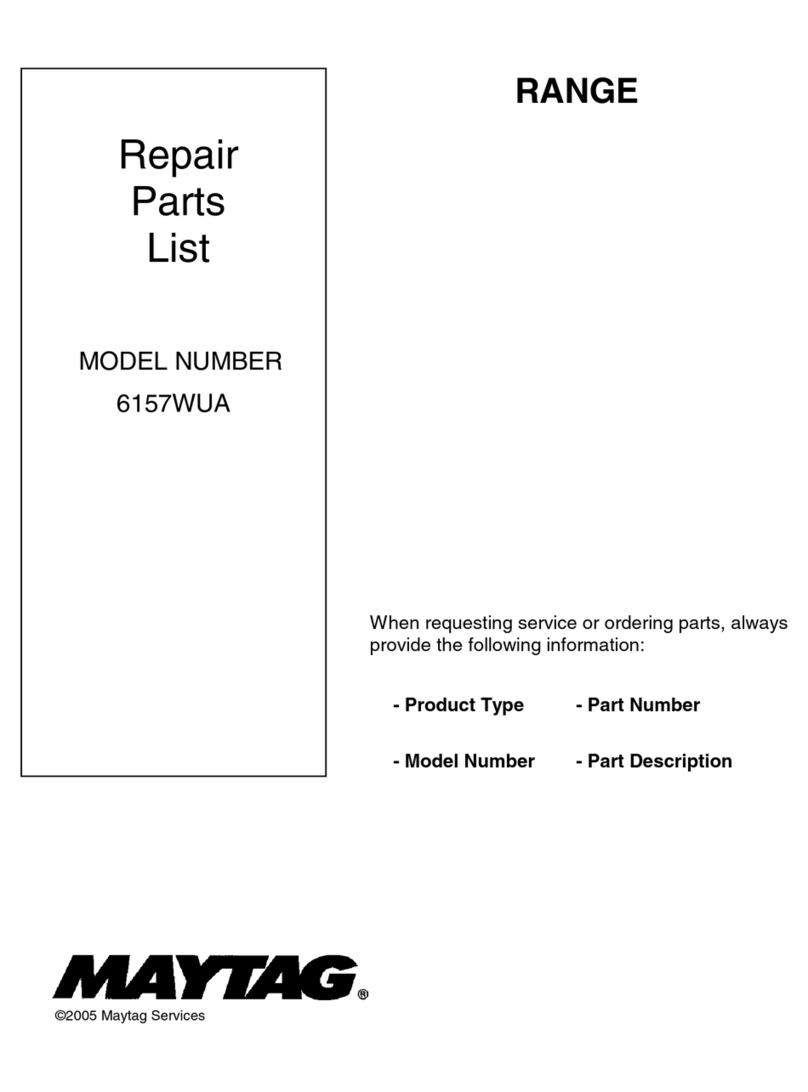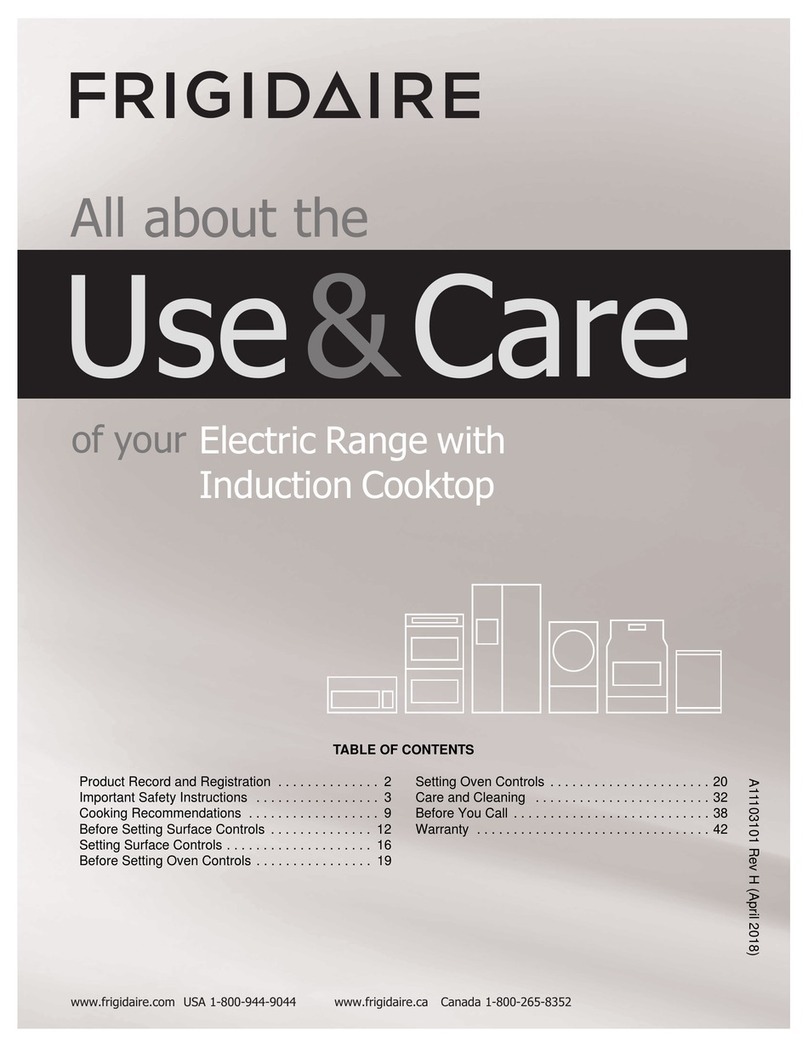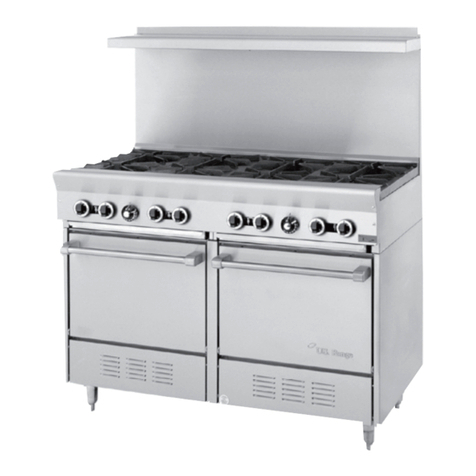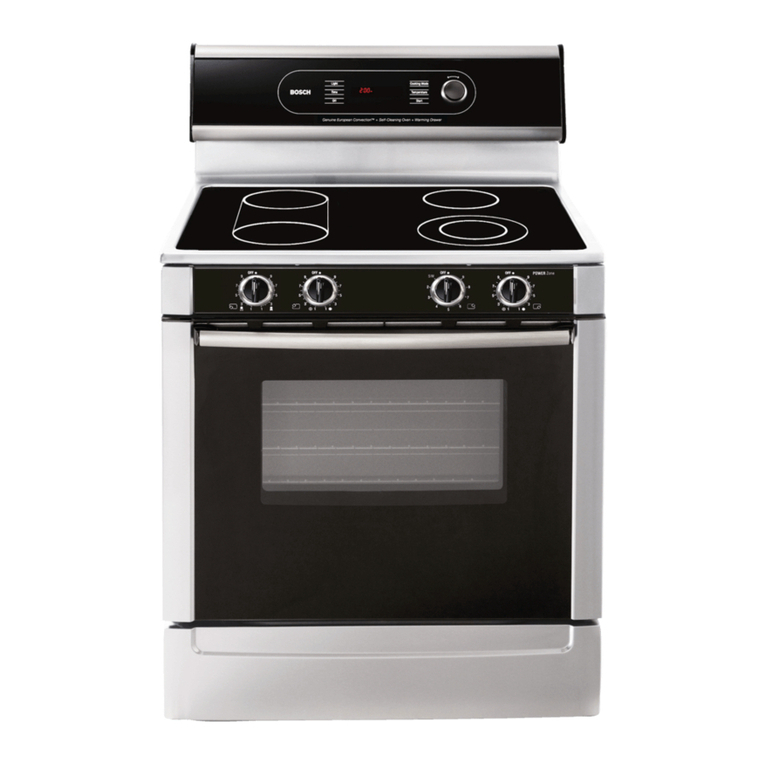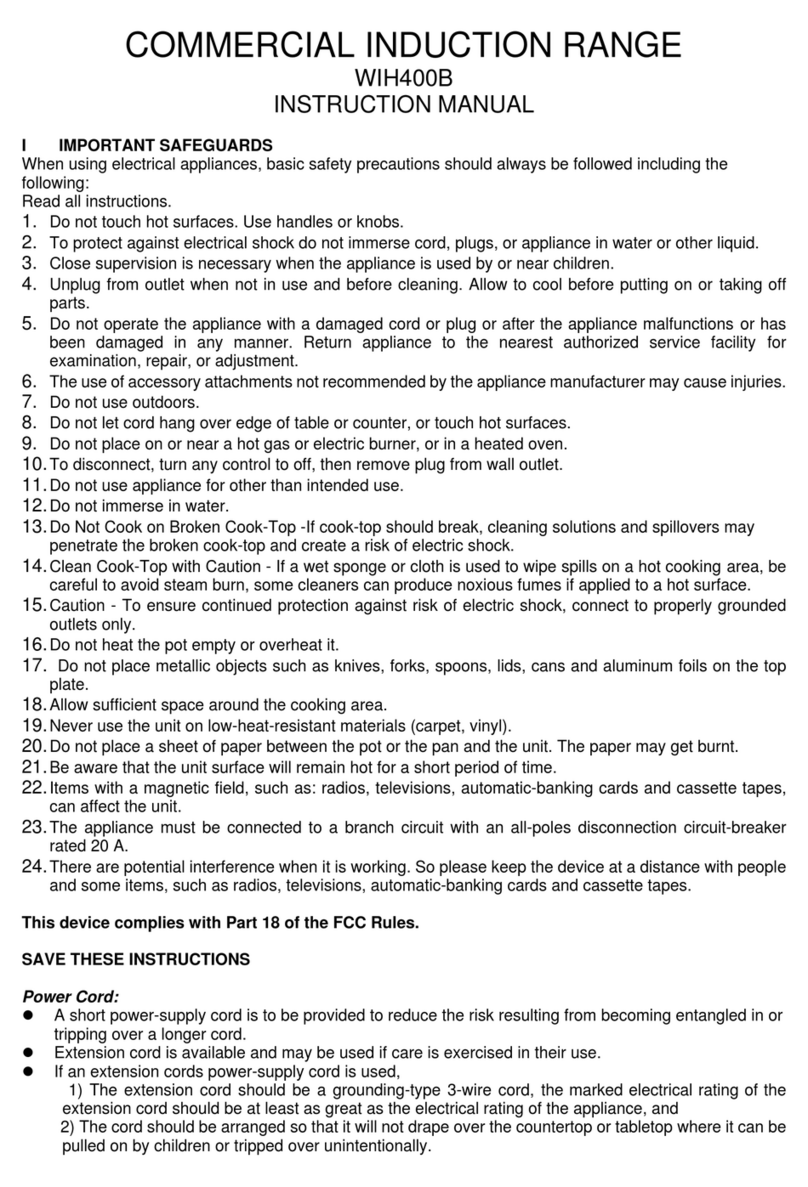Kova F766C52E101TS-PT Configuration guide

Install
Instructions
Appliance Name:
30” Digital Electric Range
Part Number:
F766C52E101TS-PT
Read these instructions completely and carefully. Save these instructions for
local inspector’s use. Observe all governing codes and ordinances.
Note to Installer – Be sure to leave these instructions with the Consumer.
Keep these instructions for future reference. Product failure due to improper
installation is not covered under warranty agreement.

30" Electric Free-
Standing Range
Cuisinière électrique
autoportante de 30"
IMPORTANT SAFETY INSTRUCTIONS
Carefully read the important information regarding installation, safety and
maintenance. Keep these instructions for future reference.
INSTRUCTIONS IMPORTANTES DE SÉCURITÉ
Lire attentivement l’importante information concernant la sécurité,
l’installation et l’entretien. Conserver ces instructions pour référence future.
MAAN2203-01
Instalation Instructions
Instructions d'installation



2
Range Safety
Your safety and the safety of others are very important.
We have provided many important safety messages in this manual
and on your appliance. Always read and obey all safety messages.
DANGER
WARNING
CAUTION
This is the safety alert symbol.
This symbol alerts you to potential hazards that can
kill or hurt you and others. All safety messages will
follow the safety alert symbol and either the word
“DANGER,” “WARNING” or “CAUTION.”
These words mean:
An imminently hazardous situation. You
could be killed or seriously injured if
you don’t immediately follow instructions.
A potentially hazardous situation which, if
not avoided, could result
in death or serious bodily injury.
A potentially hazardous situation
which, if not avoided, may result
in moderate or minor injury.
All safety messages will tell you what the potential hazard is, tell
you how to reduce the chance of injury, and tell you what can
happen if the instructions are not followed.

Tip Over Hazard
WARNING
3
State of California Proposition 65 Warnings:
WARNING: This product contains one or more chemicals known to
the State of California to cause cancer.
WARNING: This product contains one or more chemicals known to
the State of California to cause birth defects or other reproductive
harm.
A child or adult can tip the range and be killed.
Connect anti-tip bracket to rear range foot.
Reconnect the anti-tip bracket, if the range is moved.
Failure to follow these instructions can result in death or serious
burns to children and adults.
Range Safety

4
TOOLS AND PARTS
Gather the required tools and parts before starting installation. Read and follow
the instructions provided with any tools listed here.
TOOLS NEEDED
•Tape Measure
•Flat-Blade Screwdriver
•Phillips Screwdriver
•Level
•Cordless Electric Drill
•Hammer
•Wrench or Pliers
•Metal Saw
•Metal Snips or Large Wire Cutters
•15/N6" Combination Wrench
•3/8" Nut Driver
•1/4" Nut Driver
•1/8" (3.2 mm) Drill Bit (for wood oors)
•Marker or Pencil
•Masking Tape
PARTS SUPPLIED
Check that all parts are included.
a
b
a 16 x 15/8" Screws (2)
b Anti-tip Bracket
NOTE: The Anti-tip bracket must be securely mounted to the suboor.
The thickness of ooring may require longer screws to anchor bracket to
suboor. Longer screws are available from your local hardware store.
PARTS NEEDED
If using a power supply cord:
•A UL listed power supply cord kit marked for use with ranges. The cord should
be rated at 250 volts minimum, 40 amps or 50 amps that is marked for
use with nominal 13/8" (3.5 cm) diameter connection opening and must
end in ring terminals or open-end spade terminals with upturned ends.
•A UL listed strain relief.
If direct wiring:
•Flexible Metal Conduit
•UL Listed Conduit Connector
•4- ire or 3- ire Electrical Cable (where local codes permit a 3-wire connection).
•UL Listed Wire Connectors
Check local codes. Check existing electrical supply. See the appropriate
“Electrical Requirements” section. It is recommended that all electrical
connections be made by a licensed, qualied electrical installer.
Installation Requirements

5
LOCATION REQUIREMENTS
VENTILATION
IMPORTANT: Observe all governing codes and ordinances.
•It is the installer’s responsibility to comply with installation clearances, if
specified, on the model/serial rating plate. The model/serial rating plate is
located on the left-hand side of the oven frame. Open oven door to view
label. See label on back panel of range for additional element and oven
power ratings.
a
a Rating Plate
TEMPERATURE
IMPORTANT: Some cabinet and building materials are not designed to
withstand the heat produced by the oven for baking and self-cleaning. Check
with your builder or cabinet supplier to make sure that the materials used will
not discolor, delaminate or sustain other damage.
•Contact a qualified floor covering installer to check that the floor covering
can withstand at least 200°F (93°C).
•Use an insulated pad or 1/4" (0.64 cm) plywood under range if installing
range over carpeting.
GENERAL
•The range should be located for convenient use in the kitchen.
•Recessed installations must provide complete enclosure of the sides and
rear of the range.
•To eliminate the risk of burns or fire by reaching over heated surface units,
cabinet storage space located above the surface units should be avoided. If
cabinet storage is to be provided, the risk can be reduced by installing a
range hood or microwave hood combination that projects horizontally a
minimum of 5" (12.7 cm) beyond the bottom of the cabinets.
•All openings in the wall or floor where range is to be installed must be sealed.
•Do not seal the range to the side cabinets.
•Grounded electrical supply is required. See “Electrical Requirements” section.
Installation Requirements

6
DIMENSIONS
PRODUCT/OPENING
Opening dimensions shown are for 25" (64 cm) countertop depth, 24" (61 cm)
base cabinet depth and 36" (91.4 cm) countertop height.
30" (77 cm)
Min.
a
5.9" (15 cm)
Min.
b
c
ed
Dimension
a 30" (76 cm)
b 29 7/8" (76 cm)
c 25" (63.5 cm)
d 36" (91.4 cm)
e 37 3/4" (96 cm)
NOTE: Range can be raised approximately 1" (2.5 cm) by adjusting the leveling
legs. Front of door and drawer may extend farther forward depending on styling.
BACK OF RANGE
a
b
c
a Access Panel to Electrical
Supply Connection
b Power Cord Opening
c Recessed Area
Installation Requirements

7
POWER SUPPLY
IMPORTANT: To connect to an outlet in the wall, the electrical outlet must be
recessed. If the electrical outlet is in the floor, it can be either recessed or
surface mounted.
a
b
d
ce
a 30" (76 cm)
b 171/2" (44 cm)
c 71/4" (18.4 cm)
d 3" (7.6 cm)
e Recommended
Location for
Electrical Outlet
ELECTRICAL REQUIREMENTS
IMPORTANT: This appliance is manufactured with the chassis connected to the
neutral by a green ground jumper wire. Use a 3-wire, UL listed, 50-amp power
supply cord (pigtail); or if local codes do not permit ground through the neutral,
use a 4-wire power supply cord rated at 250 volts, 50 amps and intended for
use with ranges. The ground must be revised so the green ground wire of the 4-
wire power supply is connected to the chassis. See “4-Wire Connection: “Power
Supply Cord” and “Direct Wire - U.S.A. Only” “4-Wire Connection (Ungrounded
Neutral)” sections.
If codes permit and a separate ground wire is used, it is recommended that
a qualified electrical installer determine that the ground path is adequate
and wire gauge is in accordance with local codes.
To properly install your range, you must determine the type of electrical
connection you will be using and follow the instructions provided for it here.
•Range must be connected to the proper electrical voltage and frequency as
specified on the model/serial number rating plate. All models are dual rated,
and designed to be connected to either 120/208 or 120/240V AC, 60Hz, 3-
wire or 4-wire, single-phase power supply.
Voltage and
Frequency Amps Circuit Required
240V, 60 Hz 50 A 50 Amp Circuit
208V, 60 Hz 43 A 45 Amp Circuit
•When a 4-wire, single phase 120/240 volt, 60 Hz., AC only electrical
supply is available, a 50-amp maximum circuit protection is required (or, if
specified on the model/serial rating plate, when a 4-wire, single phase
120/208 volt 60 Hz., AC only electrical supply is available, a 45-amp
maximum circuit protection is required).
Installation Requirements

Electrical Shock Hazard
WARNING
8
•For direct wire installations, install a suitable conduit box (not furnished).
An appropriately sized, UL conduit connector must be used to correctly
attach the conduit to the junction box.
IMPORTANT: Local Codes may vary; installation electrical connections
and grounding must comply with all applicable local codes.
ELECTRICAL REQUIREMENTS - U.S.A. ONLY
Do not use an extension cord.
Be sure that the electrical connection and wire size are adequate and in
conformance with the National Electrical Code, ANSI/ NFPA No. 70-latest
edition and all local codes and ordinances.
A copy of the above code standards can be obtained from:
National Fire Protection
Association One Batterymarch
Park
Quincy, MA 02269
The electrical power to the oven branch circuit must be shut off
while line connections are being made.
Do not use an extension cord with this appliance.
Electrical ground is required on this appliance. The free end of the
green wire (the ground wire) must be connected to a suitable
ground. This wire must remain grounded to the oven.
If cold water pipe is interrupted by plastic, non metallic gaskets,
union connections or other insulating materials, DO NOT use for
grounding.
DO NOT ground to a gas pipe.
DO NOT have a fuse in the NEUTRAL or GROUNDING circuit. A
fuse in the NEUTRAL or GROUNDING circuit could result in an
electrical shock.
Check with a qualified electrician if you are in doubt as to whether
the appliance is properly grounded.
Failure to do so could result in death, fire or electric shock.
The range is not equipped with a power cord. The range can be fitted with a 3 or
4-wire NEMA 14-50 or 10-50 type SRDT or ST (as required) power cord rated at
250 volt AC minimum, 50 amp, with 3 open-end spade lug connectors with
upturned ends or closed loop connectors and marked for use with ranges.
•A UL listed strain relief must be attached to the range to hold the power cord.
Installation Requirements

9
•Do not use an aluminum wire receptacle with copper-wired power cord and
plug (or vice versa). The proper wiring and receptacle is a copper-wired
power cord with a copper-wired receptacle.
•The electrical outlet should be located so that the power cord is accessible
when the range is in the installed position.
ELECTRICAL REQUIREMENTS - CANADA ONLY
Disconnect power before servicing.
Plug into a grounded outlet.
Do not use an extension cord.
Failure to do so can result in death, fire, or electrical shock.
If codes permit and a separate ground wire is used, it is recommended that
a qualified electrical installer determine that the ground path is adequate
and wire gauge are in accordance with local codes.
Be sure that the electrical connection and wire size are adequate and in
conformance with CSA Standard C22.1, Canadian Electrical Code, Part 1 -
latest edition, and all local codes and ordinances.
A copy of the above code standards can be obtained from:
Canadian Standards
Association 178 Rexdale Blvd.
Toronto, ON M9W 1R3
CANADA
•Check with a qualified electrical installer if you are not sure the range is
properly grounded.
•This range is equipped with a CSA International Certified Power Cord
intended to be plugged into a standard 14-50R wall receptacle. Be sure the
wall receptacle is within reach of range’s final location.
•Do not use an extension cord.
Installation Requirements
Electrical Shock Hazard
WARNING

Excessive Weight Hazard
WARNING
10
IMPORTANT: This appliance shall be installed only by authorized persons and in
accordance with the manufacturer’s installation instructions, local gas fitting
regulations, municipal building codes, electrical wiring regulations, local water
supply regulations.
STEP 1 - UNPACK RANGE
Use two or more people to move and install range.
Failure to do so can result in back or other injury.
1. Remove shipping materials, tape and film from the range. Keep
cardboard bottom under range. Do not dispose of anything until the
installation is complete.
2. Remove oven racks and parts package from oven and shipping materials.
3. To remove cardboard bottom, first take four cardboard corners from the
carton. Stack one cardboard corner on top of another. Repeat with the
other two corners. Place them lengthwise on the floor behind the range to
support the range when it is laid on its back.
4. Using two or more people, firmly grasp the range and gently lay it on its
back on the cardboard corners.
5. Remove cardboard bottom.
NOTES:
•The leveling legs can be adjusted while the range is on its back.
•To place range back up into a standing position, put a sheet of
cardboard or hardboard on the floor in front of range to protect the
flooring. Using two or more people, stand range back up onto the
cardboard or hardboard.
Installation Instructions

11
STEP 2 - INSTALL ANTI-TIP BRACKET
Installation Instructions
NOTE: An anti-tip bracket kit is provided with the range.
WARNING: Tip Over Hazard
• A child or adult can tip the range and be killed.
• Connect anti-tip bracket to rear range foot.
• Reconnect the anti-tip bracket, if the range is moved.
• Failure to follow these instructions can result in death or serious burns to children and adults.
IMPORTANT: DO NOT completely remove the rear leveling leg. The anti-tip bracket uses either the right-hand
or left hand, rear leveling leg to secure the range to the floor.
1: LOCATE THE BRACKET
Determine the final location of the range before attempting to install the bracket.
1. Place the bracket on the floor with the back edge against the rear wall. If the range does not reach the rear
wall, align the back edge of the bracket with the rear panel of the range in its final location.
NOTE: If bracket does not touch the rear wall, you MUST screw bracket to FLOOR .
2. Position the side of the bracket against either the left or right cabinet. If there is no adjacent cabinet, align
the edge of the bracket with the side panel of the range in its final location. If the countertop overhangs
the cabinet, offset the bracket from the cabinet by the amount of overhang.
3. Mark the location for the pair of holes to be used (see illustration above).
NOTE: For FLOOR installation use either Loc A or B. For REAR WALL installation use Loc C.
2: SECURE THE BRACKET
The bracket must be screwed to either the FLOOR or REAR WALL.
FLOOR Installation:
•WOOD FLOOR: Use the screws provided to secure the bracket using the pair of marked holes (either Loc A or B).
• CONCRETE FLOOR: Using a concrete bit, drill a 5/32” pilot hole 2” deep into the concrete at the center of
each of the marked holes (either Loc A or B). Use the screws provided to secure the bracket into the floor.
REAR WALL Installation: Use the 2 screws provided to secure the bracket using the pair of marked holes at Loc C.
The screws MUST enter into a wood sill plate. If the wall contains any metal studs or similar materials, then the
floor must be used.
Figure 10
Adjacent cabinet
or final location
of range side panel
Loc A Loc B
Loc C
Rear Wall
Two screws must
enter floor or wall
at Loc A, B, or C.
Figure 11
Attachment to Floor or Rear Wall
Wall Sill Plate
Screw must enter wood
Bracket
Screw must enter
wood or concrete
3: CHECK THE BRACKET
After installing the bracket, slide the range into its final location. The rear leveling leg must be fully inserted
into the ANTI-TIP bracket as shown in Step 1. To check if the bracket is installed and engaged properly, look
underneath the range to see that the rear leveling leg is engaged in the bracket. On some models, the storage
drawer or kick panel can be removed for easier inspection. If visual inspection is not possible, slide the range
forward, confirm the anti-tip bracket is securely attached to the floor or wall, and slide the range back so the
leveling leg is under the anti-tip bracket. If the range is pulled from the wall for any reason, always repeat this
procedure to verify the range is properly secured by the anti-tip bracket.
NOTE: The anti-tip bracket must be PROPERLY INSTALLED and the rear leveling leg must be FULLY ENGAGED
into the bracket to prevent the range from tipping. NEVER remove the leveling legs. This will prevent the range
from being secured to the ANTI-TIP bracket properly.

WARNING
Electrical Shock Hazard
12
STEP 3 - MAKE ELECTRICAL CONNECTION
After reading the requirements for each Electrical Connection method, follow
the instructions specific to your situation.
POWER CORD - U.S.A. ONLY
Disconnect power before servicing.
Use a new 50 amp UL listed or CSA certified power supply
cord. Plug into a grounded outlet.
Do not use an extension cord.
Failure to do so can result in death, fire, or electrical shock.
3-WIRE CONNECTION: POWER SUPPLY CORD
IMPORTANT: Use this method only if local codes permit connecting chassis
ground conductor to neutral wire of power supply cord.
1. Disconnect power.
2. Remove the access panel located on the bottom right-hand side of the
back panel to uncover the electrical terminal block.
a
b
c
a Access Panel to Electrical
Supply Connection
b Power Cord Opening
c Recessed Area
Installation Instructions

13
3. Install a UL listed strain relief (not provided) to the power cord opening in
the bracket, and then completely tighten the strain relief nut.
4. Thread the end of the power cord through the strain relief.
NOTE: Allow enough slack to connect the wires to the terminal
block.
c
a UL Listed Strain Relief
a
b Power Cord
b
c Jumper Wire
5. Using a 5/16" nut driver and one of the -0-32 hex nuts, connect the neutral
(white) wire from the power cord to the center terminal block post along with
the green jumper wire from the range.
6. Using 10-32 hex nuts, connect the red and black wires from the power cord
to the outer posts of the terminal block with the corresponding red and
black wires from the range.
7. Tighten the hex nuts completely, and then verify the connection.
NOTE: For power supply cord replacement, use only a power cord rated
at 250volts minimum, 50-amps that is marked for use with nominal 1 3/8"
(3.5cm) diameter connection opening, with ring terminals and marked for
use with ranges.
8. Position the lower part of the strain relief under the power cord and tighten
the strain relief screws.
NOTE: Before tightening, make sure the strain relief is positioned over the
cord and NOT the wires.
9. Replace the electrical access panel.
10. Plug range into grounded outlet.
11. Tuck excess power cord into the recessed area of the back panel.
Installation Instructions

14
4-WIRE CONNECTION: POWER SUPPLY CORD
IMPORTANT: Use this method for new branch-circuit installations (1996
NEC), mobile homes, recreational vehicles, or in an area where local codes
prohibit grounding through the neutral.
1. Disconnect power.
2. Remove the access panel located on the bottom right-hand side of the
back panel to expose the electrical terminal block.
a
b
c
a Access Panel to Electrical
Supply Connection
b Power Cord Opening
c Recessed Area
3. Install a UL listed strain relief to the power cord opening in the support
bracket, and fully tighten the strain relief nut.
4. Feed the power supply cord through the strain relief. Allow enough slack to
easily attach the wiring to the terminal block.
a
bde
c
a Ground Screw
b Terminal Block
c Jumper Wire
d Power Cord Wires
e UL Listed Strain Relief
Installation Instructions

WARNING
Electrical Shock Hazard
15
5. Remove the green jumper wire from under the ground screw and replace
with the green wire from the power cord and tighten ground screw.
6. Loop the green jumper wire removed from the ground screw back onto its
end that is fastened to the center post on the terminal block.
7. Use 5/16" nut driver to connect the neutral (white) wire to the center
terminal block post with one of the 10-32 hex nuts.
8. Using 10-32 hex nuts, connect the red and black wires from the power cord
to the outer posts of the terminal block with the corresponding red and
black wires from the range.
9. Tighten the hex nuts completely, and then verify the connection.
NOTE: For power supply cord replacement, use only a power cord rated
at 2.0volts minimum, .0-amps that is marked for use with nominal
3/8" (3..cm) diameter connection opening, with ring terminals and
marked for use with ranges.
10. Position the lower part of the strain relief under the power cord and
tighten the strain relief screws.
NOTE: Before tightening, make sure the strain relief is positioned over the
cord and NOT the wires.
11. Replace the electrical access panel.
12. Plug range into grounded outlet.
13. Tuck excess power cord into the recessed area of the back panel.
POWER CORD - CANADA ONLY
Plug into a grounded outlet.
Do not use an extension cord.
Failure to do so can result in death, fire, or electrical shock.
1. Plug into a standard 14-50R grounded wall receptacle.
2. Go to STEP 4 - INSTALL RANGE.
Installation Instructions

WARNING
Electrical Shock Hazard
16
DIRECT WIRE - U.S.A. ONLY
Disconnect power before servicing.
Improper connection of aluminum house wiring and copper
appliance leads can result in an electrical hazard or fire. If the home
has aluminum wiring, only use connectors designed and UL listed
for joining copper to aluminum and precisely follow the
manufacturer's recommended procedure. Aluminum-to-Copper
connections must conform with local codes.
Use 8 gauge copper or 6 gauge aluminum wire.
Electrically ground range.
Failure to do so can result in death, fire or electrical shock.
Be sure your appliance is properly installed and grounded by a qualified
technician. Ask your dealer to recommend a qualified technician or an
authorized repair service.
•A circuit breaker is recommended.
•The range can be connected directly to the circuit breaker box (or fused
disconnect) through flexible or nonmetallic sheathed, copper or aluminum
cable.
•Allow at least 6 ft (1.8 m) of slack in the line so that the range can be
moved if servicing is ever necessary.
•A UL listed conduit connector must be provided at each end of the power
supply cable (at the range and at the junction box).
•Wire sizes and connections must conform with the rating of the range.
•The tech sheet and wiring diagram are included with the range.
This appliance is manufactured with the chassis connected to the neutral by a
green ground jumper wire. After making sure that the power has been turned
off, connect the flexible conduit from the oven to the junction box using a UL
listed conduit connector. The Grounded Neutral and Ungrounded Neutral
Graphics on the following pages and the instructions provided, present the
most common way of connecting the ovens. Your local codes and ordinances,
of course, take precedence over these instructions. Complete electrical
connections according to local codes and ordinances.
Installation Instructions

WARNING
Electrical Shock Hazard
17
3-WIRE CONNECTION (GROUNDED NEUTRAL)
Grounding through the neutral conductor is prohibited for new
branch-circuit installations (1996 NEC); mobile homes; and
recreational vehicles, or in an area where local codes prohibit
grounding through the neutral conductor. For installations where
grounding through the neutral conductor is prohibited, see the
Ungrounded Neutral graphic.
Use grounding terminal or lead to ground unit.
Connect neutral terminal or lead to branch circuit neutral in
usual manner.
Failure to do so could result in death, fire or electric shock.
Connect to the House Electrical Supply
IMPORTANT: Use the 3-wire cable from home power supply where local
codes permit a 3-wire connection.
1. Disconnect power.
Grounded Neutral
a
b
c
d
g
h
f
e
i
a Junction Box
b Black Wires
c Neutral (White)
Wire
d Ground (Green or
Bare) Wire
e Cable from Range
f UL Listed Conduit
Connector
g Red Wires
h UL Listed Wire Connectors
i House Electrical Supply
2. Connect the 2 black wires btogether using a UL listed wire connector.
Installation Instructions
Table of contents
Languages:
Popular Range manuals by other brands

Bartscher
Bartscher 115.090 Instructions for installation, operation and maintenance
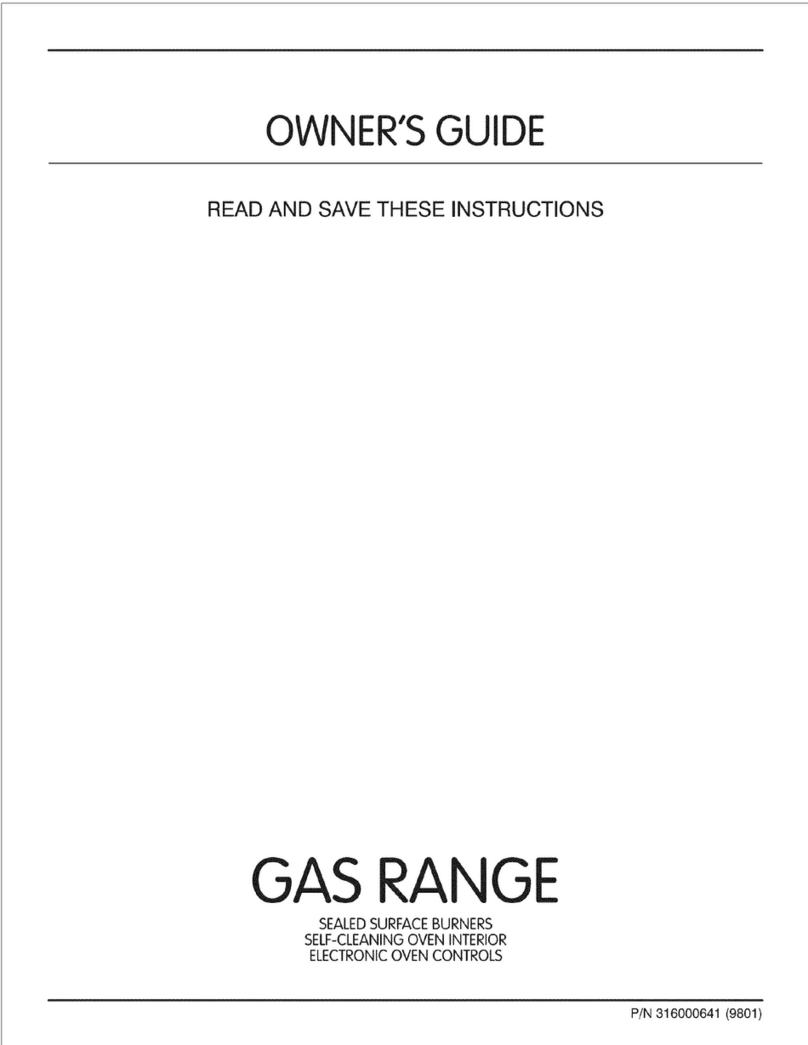
Frigidaire
Frigidaire MGF355BGWA owner's guide

Thor Kitchen
Thor Kitchen HRT3003U User manual & owner's guide
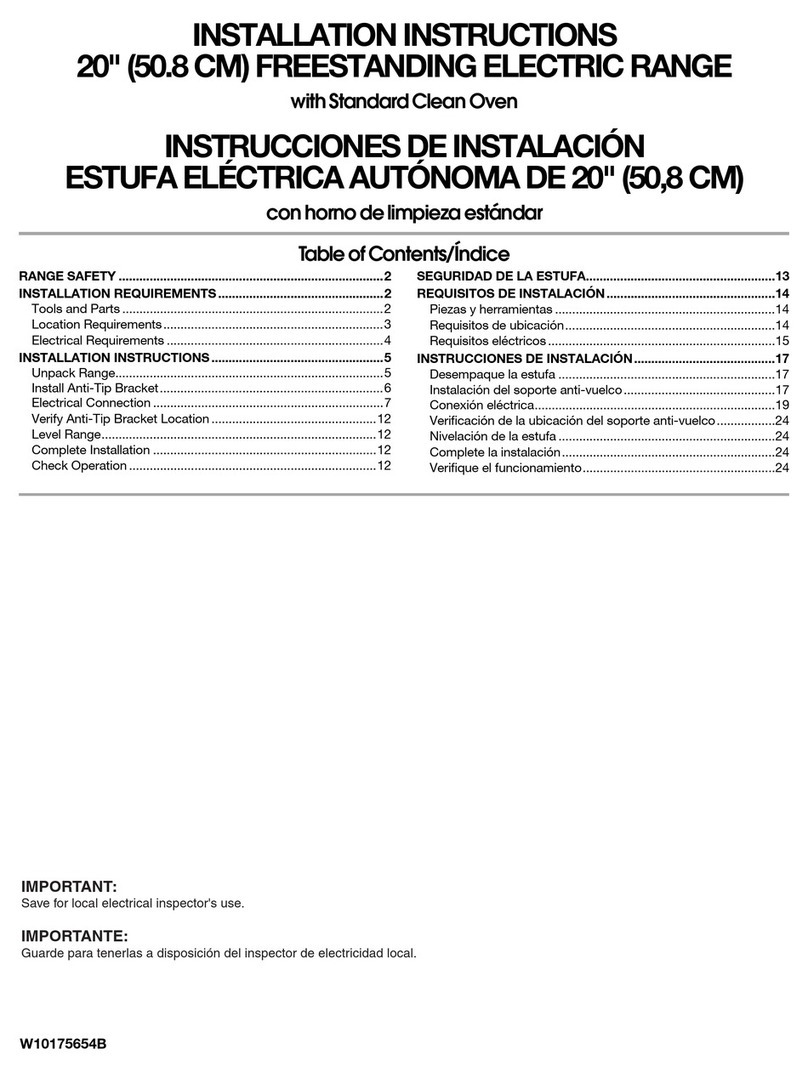
Amana
Amana AEP200VA installation instructions
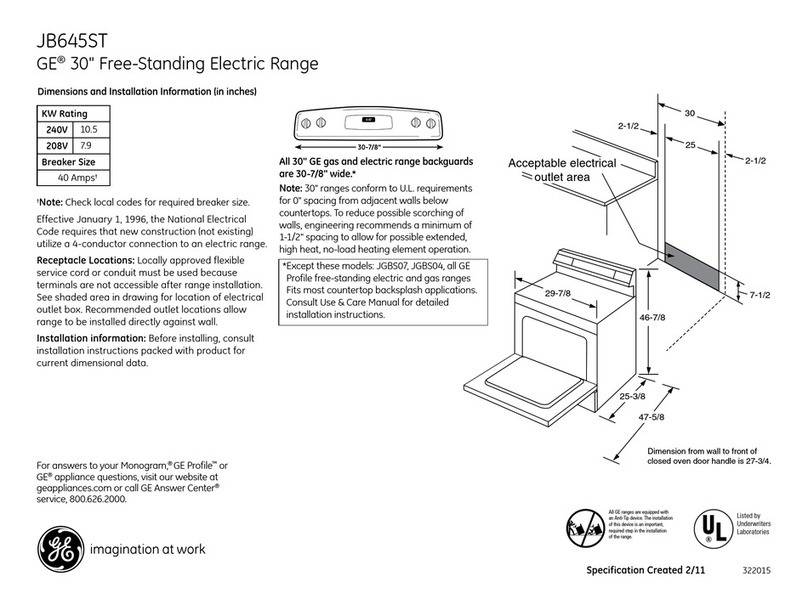
GE
GE JB645STSS Dimensions and installation information

Kenmore
Kenmore 79031033803 installation instructions

Hotpoint
Hotpoint RB790 - 30 in. Electric Range Specifications
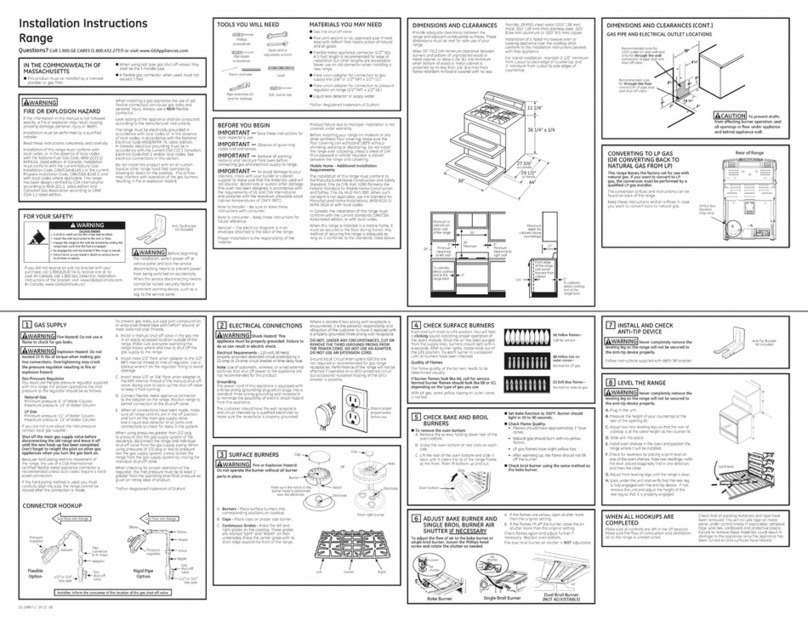
GE
GE JGB850DEF2BB installation instructions

edenox
edenox BMP-25 instructions
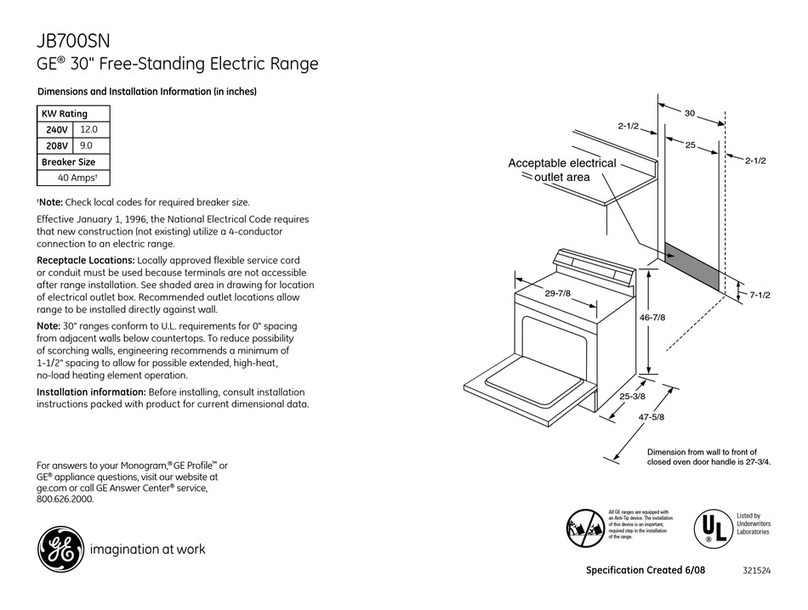
GE
GE JB700SNSS Dimensions and installation information
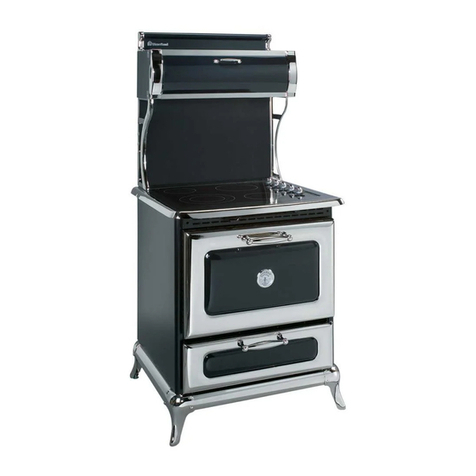
Heartland
Heartland Classic 6200 Installation and operating instructions
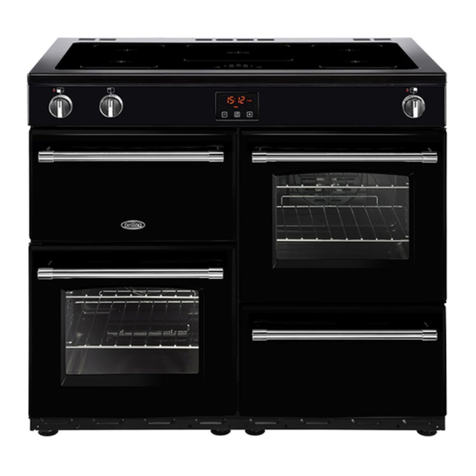
Belling
Belling Belling Users guide & installation handbook
